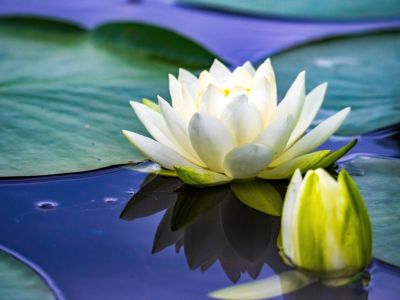Water lily plants can be divided into two types:
Hardy – Hardy types are best for northern climates where the water freezes in winter. As long as the roots of hardy specimens are below the level where the water freezes, they will reappear the following spring. Tropical – Tropical water lilies won’t survive in cold water and must be brought indoors for winter in all but the warmest areas. Many growers treat them as annuals, replanting them each year. Otherwise, remove them from the pond, clean them up, and store them in a bucket of moist sand in a cool basement before the first freeze. Tropical water lily plants can be further divided into two groups: day bloomers and night bloomers. White night bloomers look spectacular with nothing more than moonlight to illuminate them, but blues, purples, reds, and pinks are very difficult to see in the dark. Avoid these colors unless the pond is illuminated by artificial light at night.
How to Grow a Water Lily
A pond or pool covered in water lilies is attractive, but complete coverage prevents light from penetrating into the water, choking out other plant and animal life. Growing water lilies in containers helps keep them from spreading and taking over a small pond and it makes water lily care much easier. When you are growing water lilies, use a large plastic pot with several holes punched in the sides and bottom. Fill the pot to within 3 inches (8 cm.) of the top with silt, loam, or clay soil and mix in a small amount of slow-release fertilizer labeled for use with aquatic soil. Plant the rhizome close to one side of the pot at a 45-degree angle with the eye pointing up. Cover the soil with a layer of pea gravel, keeping the gravel away from the top of the rhizome as much as possible. The gravel keeps the soil from floating off or washing out of the pot. Place the pot in the bottom of the pond, adjusting the depth to that recommended for your specific variety. Most call for a depth of between 6 and 18 inches (15-46 cm.). If necessary, you can raise the depth by placing the pot on top of rocks. NOTE: For those having fish in their water garden, water lilies should NOT be potted in regular potting soil, as this contains a lot of organic material that will eventually rot and foul the water. Remove any rotting organic material from your pond or water garden, as this is a breeding ground for anaerobic bacteria and pathogens and may add unwanted excess nutrients to feed algae blooms. Instead, pot water lilies, and any other pond plant, in a heavy clay soil and cover with fist sized rock, and then river rock to prevent fish from rooting around in the pot and sending the planting medium into the pond. A few simple preventative steps up front are far easier to take than trying to treat sick and dying fish later.
Water Lily Care
Once planted, taking care of water lilies is easy. In fact, most require no care at all other than dividing them every three or four years to rejuvenate them and to keep them from spreading into unwanted areas.
